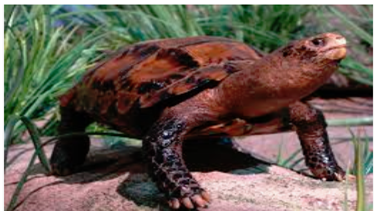

A team of herpetologists from the Forest Department and two NGOs, Help Earth and Turtle Survival Alliance (TSA), found a pair of the rare species,Impressed Tortoise (ManouriaImpressa) in Arunachal Pradesh.
Context
A team of herpetologists from the Forest Department and two NGOs, Help Earth and Turtle Survival Alliance (TSA), found a pair of the rare species,Impressed Tortoise (ManouriaImpressa) in Arunachal Pradesh.
About
More on news
- This is the first-ever recorded sighting (not discovery) in India of this tortoise which is on a red list of threatened species, taking the count to five and the non-marine chelonian count to 29. Chelonian is an order of reptile that includes turtles, terrapins and tortoises.
- The species has a golden brown shell and skin.

- There are only two species of tortoises under the Manouria genus. Northeast India was known to be the home of only the Asian Forest Tortoise (Manouriaemys) until the discovery of the Impressed Tortoise.
- The male Impressed Tortoise is smaller than the female which is 30 cm in length, so it is medium sized. This Manouria species is one-third the size of the Asian Forest Tortoise.
- Turtle Survival Alliance, an organisation working towards tortoise conservation, described it as a 'critically endangered' tortoise species which was elusive, vulnerable, and most importantly, never been sighted in India.
- It inhabits hilly regions, moist primarily forest hill tracts of the Indo-Burma hot spot (Cambodia, China, Laos, Malaysia, Myanmar, Thailand and Vietnam). Its habitat is difficult to access and that makes its protection tough.
- The last reported range extension of the species was from Gwa, Myanmar. The records of IUCN (International Union for Conservation of Nature) show it to be fungivorous (fungi-eating). It is also considered difficult specie for captive breeding. The clutch size (number of eggs laid at a time) is 10-21 eggs and not much is known of its nesting behaviour.
- The impressed tortoise measures one foot, and has a ‘brilliant’ spine, which is bent upwards and beautifully serrated. It’s a magnificent looking creature — impressive in colour and shape. That is why it’s called the impressed tortoise in the first place.
Implications of the finding
- It hailed it as a landmark moment in turtle conservation.The implications of the finding is big since always in our country, in conservation action plan, lesser animals are sidelined, always the focus is on elephants, tigers or rhinos and may be this discovery will create an impact, very little may be but a perception change might come and more researchers will join in turtle conservation.
- With this discovery, India becomes the third most turtle-rich country in the world. There are 24 turtles (aquatic) species found in the country.
|
Tortoises differ from turtles on account of being terrestrial animals. But it is common for conservationists to club the former with the latter for practical purposes. Western Ghats and the Northeast are the two main biodiversity hotspots for turtles. |
Recent Discoveries
|
Species |
Biological Name |
Found From |
|
Diatom |
GomphonemaMayamae |
Arunachal Pradesh |
|
Eel |
MonopterusRongsaw |
Meghalaya |
|
Snake |
UropeltisBhupathyi |
Forests of the Anaikatty hills in Tamil Nadu’s Coimbatore district |
|
Moth |
EucyclodesGavissima |
Papikonda national park, Andhra Pradesh |
|
Lizard |
SitanaAttenboroughii |
Poovar Coast in Thiruvananthapuram, Kerala |
|
Frog |
MicrohylaKodial |
Coastal Karnataka region |
|
Bivalve |
IndospheniaKayalum |
Kochi backwaters, Kerala |
|
Water strider |
PtilomeraNagalanda |
River Intanki, Peren district, Nagaland |
|
Fish |
Dario Neela |
Karnataka (Western Ghats) |
|
Hog Deer |
Axis PorcinusAnnamiticus |
KeibulLamjao National Park, Manipur |
|
Lizard |
MonilesaurusMontanus |
Karnataka (Western Ghats) |


